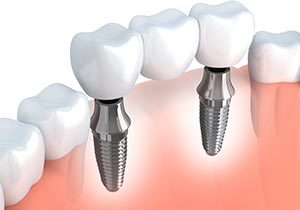Glacier Centre for Dentistry
Dr. Kurt Lindemann, DDS /

Dental Bridges in Kalispell
If you’re looking to fix a slightly marred cosmetic dental blemish with a dental bridge in Kalispell then Glacier Centre for Dentistry has you covered! Made of natural, tooth-colored materials, a dental bridge looks like a real tooth would. Cosmetic dental bridges are used to fill in a missing or badly decayed tooth by “bridging” the gap of the surrounding teeth. The bridge would consist of a pontic (tooth filler) and be fitted to the two adjacent teeth or abutments surrounding the missing tooth using dental crowns.
A patient can incur negative effects by leaving the missing tooth untreated. Leaving spaces in the mouth can cause multiple teeth to shift and move which can cause occlusion (biting problems) and/or TMJ jaw issues. Periodontal problems (gum disease) can also occur at the site of the missing and surrounding teeth. Having a dentist treat a missing or badly decayed tooth is critical to preventing any further complications.
Implant Supported Dental Bridge
 Implant supported dental bridges are extremely similar to traditional bridges, except they are supported by dental implants and not natural teeth. This procedure is a great option for patients missing several adjoining teeth. Implants are a permanent procedure that will help prevent bone deterioration and gum recession. This procedure may also be recommended when too much pressure might be placed on a single implant. For example, clenching or grinding teeth can put a lot of pressure on an individual implant, increasing the chances it could fail. An implant supported dental bridge can reduce the pressure on an individual implant, spreading it across the whole bridge. Each patient will always be evaluated on a case by case basis.
Implant supported dental bridges are extremely similar to traditional bridges, except they are supported by dental implants and not natural teeth. This procedure is a great option for patients missing several adjoining teeth. Implants are a permanent procedure that will help prevent bone deterioration and gum recession. This procedure may also be recommended when too much pressure might be placed on a single implant. For example, clenching or grinding teeth can put a lot of pressure on an individual implant, increasing the chances it could fail. An implant supported dental bridge can reduce the pressure on an individual implant, spreading it across the whole bridge. Each patient will always be evaluated on a case by case basis.
All Types of Dental Bridges
Traditional dental bridges - Traditional bridges are supported by two crowns on either side of the gap in a patient’s teeth. These two adjacent teeth would be reshaped to fit crowns on both sides of the gap. The crowns would be placed on both adjacent teeth with the bridge fitted in between the two crowns.
Implant supported bridges - More recently, implant supported bridges have become popular. This makes use of the bridge fitted on two crowns that are resting on surgically implanted posts. This type of procedure can be used in patients that may be missing several teeth in a row.
Cantilever Bridges - The cantilever bridge can be thought of in the same manner as a typical industrial bridge. The dentist would attach the bridge to a crown on a single tooth, as opposed to the two adjacent teeth. Dentists would not recommend this type of bridge for molars (back teeth) as the molars bear the force of a patient’s bite. Cantilever bridges are a rare type of bridge but are still used as they tend to preserve more of a patient’s healthy tooth structure.
Maryland Bonded Bridges - This type of bridge was developed by researchers at the University of Maryland (hence the name). This type of bridge involves minimal alterations to the surrounding teeth, as it uses a set of wings that attach to adjacent teeth. Materials used to attach the bridge have generally been made out of metal, however, newer Maryland Bonded Bridges can be made from resin.




